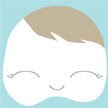Let's start at the beginning.... You have clicked over and seen Roland by now right? It is important because I used his image to design my "brother" monster for him. Here is what I came up with.
The first step for me when creating a new design is to figure out what the basic shapes of the design are. In the case of the guy above there is the outline of his body which includes the gusset (the top of the head) and the rest of the body. Here are what the pieces look like when taken apart and photocopied.
When working with fur, especially long pile fur, it is important to keep in mind which way the nap of the fur is going. Depending on the look you are trying to create you will probably want the nap going all in the same direction, and usually up or down. Sidewise fur usually looks funny although you might be going for that. The bottom line is just to be aware so you aren't surprised or disappointed when you turn your pieces. I want my nap laying down so here is what my pieces look like when cut out.
Usually I am opposed to pinning in all shapes and forms. This is because I am lazy and can't be bothered with it. However, I will ALWAYS break this personal rule when working with fur. Fur is slippery and thick which makes it extremely tricky to sew. The main thing you want to do when pinning your pieces is to keep the fur inside the seam facing the right side of the fabric. As you pin, keep pushing the fur down between the pieces. This will help hide the seams when you turn the fabric of your monster and also leave less fur for you to pick out of the seams later. This first picture shows how the fur is sticking out as I pin and then next shows when I have finished pinning and all the fur is nicely tucked inside.
 When you start sewing fur you might want to leave a seam allowance that is larger than you normally would leave on other fabrics. Even though you have pinned your fur it can still slide a lot and you want to make sure you get both pieces sewn together. When you are done sewing a piece make sure to check both sides to make sure they are sewn completely together. If they aren't go back over them, it doesn't matter if it looks pretty on the inside it is the outside that will count.
When you start sewing fur you might want to leave a seam allowance that is larger than you normally would leave on other fabrics. Even though you have pinned your fur it can still slide a lot and you want to make sure you get both pieces sewn together. When you are done sewing a piece make sure to check both sides to make sure they are sewn completely together. If they aren't go back over them, it doesn't matter if it looks pretty on the inside it is the outside that will count.Next you need to decide on the placement of the gusset and get it sewn on. I refer to my originally drawing at this point and notice that I want his gusset to come down a little bit as the forehead and form the top of the mouth. I eyeball it and mark where I want it to be.
Now you want to pin the gusset on really well and sew that together. It is starting to look like a furry helmet!
The mouth is the next part and again I trace the mouth from the original drawing as reference.
To make a mouth that goes in you have to create a trim around the inside of the mouth. This is done by cutting a strip from the same mouth fabric (in this case black fleece) in about an inch to two inches (or depending on how deep you want the mouth to be). Then you sew that piece to the inside of the mouth (fleece) and the outside of the mouth (fur).
 Okay this is the last progress picture and it was taken with the dreaded flash! You can see how his mouth has come together though.
Okay this is the last progress picture and it was taken with the dreaded flash! You can see how his mouth has come together though.And since that is the last of the progress photos here he is done! I am about to email Janet at ionlylikemonsters to see if she likes this guy. Wish him luck!
Boom! Done!
He thinks he is pretty funny.
Crazy arms/legs. This picture is a little creepy.
He's got his eye on you.
















I love him!!!!!!!
ReplyDeleteSuper idea!!!!!!!!!!!!!!!
ReplyDelete